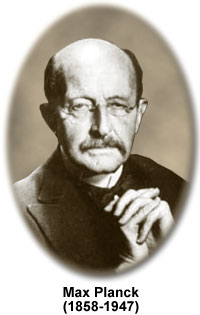Max Planck
(1858-1947)

Max Planck, a German physicist, is best known as the originator of the quantum theory of energy for which he was awarded the Nobel Prize in 1918. His work contributed significantly to the understanding of atomic and subatomic processes.
Planck was born in Kiel, Germany in 1858. At the age of nine he entered the famous Maximilian Gymnasium in Munich where he developed an interest in physics and mathematics. He was a talented musician but decided to pursue a career in physics. When Planck was only sixteen years old he entered the University of Munich. He also spent time studying at the University of Berlin, and at the age of 21 he secured a doctorate degree based on his work in thermodynamics, the study of heat and energy. He became a lecturer at the University of Munich and eventually became a full professor of theoretical physics at the University of Berlin.
Planck's work in thermodynamics led to the formulations of his quantum theory. To explain the colors of hot glowing matter, he proposed that energy is radiated in very minute and discrete quantized amounts or packets, rather than in a continuous unbroken wave. Planck called the packets of energy quanta and he was able to determine that the energy of each quantum is equal to the frequency of the radiation multiplied by a universal constant that he derived, now known as Planck's constant. This number, expressed in terms of erg-seconds, measures the energy of an individual quantum. An erg is the amount of energy needed to raise a milligram of mass by a distance of 1 centimeter. Planck's constant, expressed by the variable h in equations, is approximately 6.63 x 10(E-27) erg-second. Planck's constant has become one of the basic constants of physics. It is used to describe the behavior of particles and waves at the atomic scale.
Planck announced his findings in 1900, and in 1905, Albert Einstein used Planck's quantum theory to describe the particle properties of light. Einstein demonstrated that electromagnetic radiation, including light, has the characteristics of both a wave and, consistent with Planck's theory, a particle. These particles were later called photons. In 1913, Niels Bohr used Planck's theories to develop a new and more accurate model of the atom.
Planck made significant contributions to science throughout his life. He is recognized for his successful work in a variety of fields including, thermodynamics, optics, statistical mechanics, and physical chemistry. Unfortunately, Planck's personal life was marked by one tragedy after another. He lost his first wife to illness, both of his daughters died in childbirth, his eldest son died in World War I, and in 1944, his second son was executed by the Nazis for involvement in a plot to assassinate Hitler. Planck remained in Germany during World War II and was outspoken in his opposition to the Nazi regime. After the war, he was appointed the head of the Kaiser Wilhelm Institute, which was renamed the Max Planck Institute. Max Planck died soon afterward in 1947.
